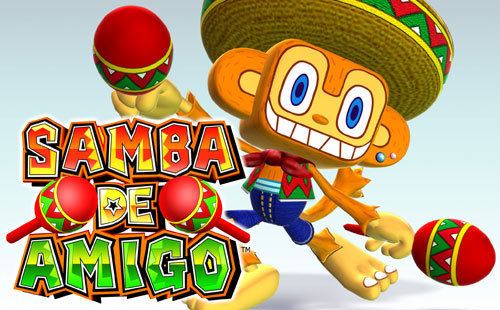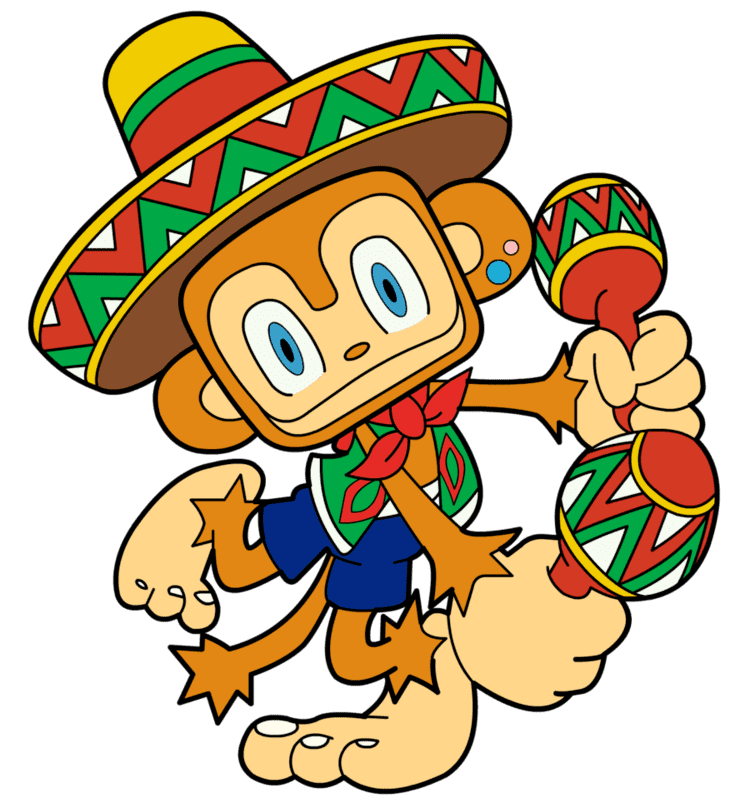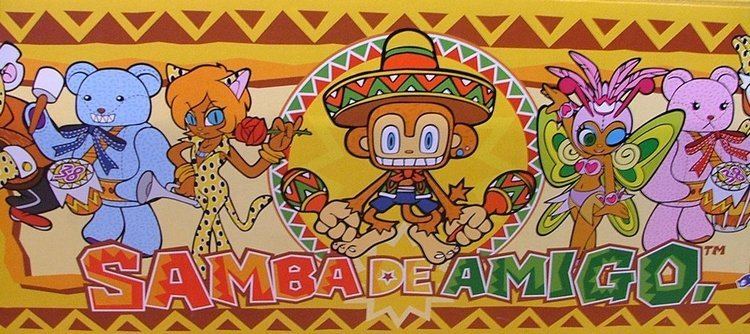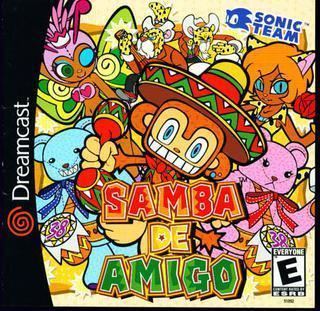8.2 /10 1 Votes
7.5/10 IGN Composer(s) Naofumi Hataya Genre Music video game | 9/10 GameSpot Artist(s) Yuji Uekawa Initial release date December 1999 Designer Shun Nakamura | |||||||||||||||||||||||||||||||||
 | ||||||||||||||||||||||||||||||||||
Similar ChuChu Rocket!, Billy Hatcher and the G, Clockwork Knight, It's Mr Pants, Kung Fu Chaos | ||||||||||||||||||||||||||||||||||
Omg kon mlg professional samba de amigo arcade player
Samba de Amigo (サンバDEアミーゴ, Sanba de Amīgo) is a rhythm game developed by Sonic Team and published by Sega. The game was released in arcades in December 1999, and for the Dreamcast video game console in 2000. A port for the Wii was also developed by Gearbox Software and Escalation Studios and released in 2008. In Samba de Amigo, the player uses controllers shaped like maracas with the goal of matching a series of patterns displayed on-screen. The music in Samba de Amigo is made of primarily popular Latin music songs rather than common or traditional samba. The game also features non-Latin pop songs.
Contents
- Omg kon mlg professional samba de amigo arcade player
- Samba de amigo arcade hard mode
- Gameplay
- Game modes
- Maraca controllers
- Samba de Amigo Ver 2000
- Hustle Mode
- Reception
- After Ver 2000
- Wii version
- Song list
- Downloadable songs
- Dreamcast
- Wii
- References

Samba de amigo arcade hard mode
Gameplay

Samba de Amigo is played with a pair of maracas. As a song plays, the player, guided by on-screen graphics, must shake the maracas at high, middle, or low heights with the beat of the music, or occasionally must strike poses with the maracas held in various positions. The player is represented on-screen by Amigo, a monkey. If the player does well, the scene around the monkey (usually a concert or a dance) will attract more people and become more vividly animated; if the player does poorly, characters leave and eventually all that's left is the monkey alone, looking sad.

In the primary game mode, each player has six spots arranged in a circle on the screen: two red meaning 'shake high,' two yellow meaning 'shake middle,' and two green meaning 'shake low.' Blue dots will appear in the center of this circle and move towards the spots; as soon as the blue dot touches a spot, the player must shake a maraca at that location. For example, if a blue dot touches the upper left spot, the player must shake either maraca above his left shoulder. If both maracas are shaken in that location, the player gets an 'Amigo' bonus. Occasionally a long line of dots will flow into a spot and the word 'Shake' appears, telling the player to continue shaking his maraca rapidly there. Sometimes a stick-figure (named "Pose") appears on the screen holding its maracas in a certain position; the player has a second or two to match the figure's pose for points.
Game modes
In the original arcade game, the player is given two or three stages to play through, depending on how the options are set. Each stage has three songs to choose from. If the player does well enough on each stage, an additional Special stage is enabled, where three of the more challenging songs are made available.
In the Dreamcast port, this version of the game is playable as Arcade mode. Original mode is the same game, except that instead of being limited to three songs in each stage, the player gets to choose from any song in the game that has been unlocked. Initially, six songs are available in this mode, while more can be unlocked by playing the Arcade or Challenge modes.
The home game also adds a Party mode, with minigames such as Guacamole (pronounced and played much the same as "Whac-A-Mole"), Strike A Pose (consisting of a long sequence of poses to make), and 1-2-Samba! (where spots must be hit in sequence - the Japanese version's name for this minigame, "Ichi Ni San-ba," is a pun on counting to three in Japanese). Also included in Party mode is the Battle game, where two players compete to score high combos and knock out their opponent, and the Couples game (known as "Love Love" in Japan), where two players play through a song to test their "compatibility". Along with this, the home version has features which can be unlocked, such as alternate sound effects and downloadable songs.
Finally, a Challenge mode has been added, where the player is given specific goals in order to proceed through stages. These goals include having to reach a certain letter grade or to pass a certain score while playing a song. There are 25 challenges total, separated into five stages.
Maraca controllers
The original arcade game used red maraca controllers modeled after their in-game design. Magnetic sensors were used to determine their position. As this was an expensive process, it had to be reworked for the home version.
In the Dreamcast version, each maraca has a cord which is plugged into to a bar that lies in front of the player's feet. The bar is slightly more than two feet in length and has a sensor at each end, and each maraca has an ultrasonic transmitter mounted on its cord; this allows the system to triangulate the position of each maraca. The rattle part can be unscrewed from the top of each maraca for quieter play. Included in the box is a plastic mat with two brown footprints, which helps players properly position themselves in relation to the sensor bar.
With the exception of the Ver. 2000 sequel, the maracas were never officially used for any other games, though they can be used with Namco's Mr Driller for approximate control of the player's character. A single maraca could also be used to control the SNK produced game Cool Cool Toon.
In the Wii version, players use the Wii Remote, in combination with either the Nunchuk or another Wii Remote. Optional, unlicensed third-party maraca attachments are also available.
In a Flash version mini game used for the promotion of the Wii version of the game, keys W, D, and C, then O, J, and N is used to tap the drums. The mini game also played an introductory movie showing a family playing the Wii version of the game.
Samba de Amigo: Ver. 2000
Samba de Amigo: Ver. 2000, was released in Japan for the arcades and the Dreamcast. It is an upgraded version, and it contains 14 new songs, as well as six new downloadable songs for the home version. Whereas in the original game, there were only three songs to choose in each stage, this version allows the player to choose several. "Love Love/Couples" Mode, originally available only in the home version of Samba de Amigo, is included in the arcade version of Ver. 2000. A new character named Amiga joins the cast. She is Amigo's sister, and wields a tambourine. In the home version, a new volleyball game replaces the original minigames. Survival mode was also added, where the player must finish as many songs in a row as they can. In addition, the Challenge mode has new goals, as well as five new secret stages that are quite difficult.
Hustle Mode
The most significant addition to Ver. 2000 is the new "Hustle Mode". In this mode, the player must still follow the dots and shake the maracas in the appropriate location, but this is done a lot less often. Instead, Pose appears frequently, and in addition to making the player do static poses, he will be shaking his maracas in certain patterns that the player must mimic. These patterns include either shaking one or both maracas back and forth between two of the six positions, doing a full 360° rotation starting from one position, and looping all the way back around,. All the songs in the game, including the ones previously found in the first version, have both Original and Hustle Mode patterns.
Samba de Amigo Ver. 2000 was announced for North American release, under the name Samba de Amigo Ver. 2001, but it was among the games that were canceled when Sega discontinued support for their console.
Reception
On release, Famitsu magazine scored the Dreamcast version of the Ver.2000 follow-up a 30 out of 40.
After Ver. 2000
That same year, Sega released a spiritual successor named Shakatto Tambourine. It was very much the same game as Samba de Amigo, except played with a tambourine controller, and featuring popular J-pop music. Samba de Amigo also made a comeback of sorts in the EyeToy game Sega Superstars, where player movements recorded by the EyeToy camera were recorded in place of the original maracas. A pair of Samba de Amigo themed levels appeared in the 2012 Nintendo 3DS game, Rhythm Thief & the Emperor's Treasure, which are played using buttons and the system's gyroscope.
Wii version
In mid-2007, veteran developers Gearbox Software came up with the idea to port the game to the Wii console, and upon Sega's approval, began working on the new version with Sonic Team as consultants. The default setting of the game uses the Wii Remote and Nunchuk to simulate the maraca-shaking from the original game, with the option to use two remotes for completely wireless play. Optional maraca-shaped attachments are also available to provide the full experience. Unlike the maraca controls of the Dreamcast version which could detect the height at which they were shaken, the Wii sensor bar is not capable of this. Instead, the angle at which the Wii Remote is being shaken determines if high, mid or low notes are hit. The rotation of the controller also has an effect on note detection, especially when doing cross-over moves.
All the characters and stage designs from the original game return with enhanced graphics. Many of the additions from Ver.2000 that were not available to people outside Japan are included, such as Hustle Mode and the new character Amiga. A "Career" mode exclusive to the Wii version is included, consisting of challenges in which players must clear songs to earn various unlockables, including maraca effects and additional songs. Unique to the Wii version, new stages based on other Sega games were added, including ones based on Sonic the Hedgehog and Space Channel 5, complete with cameos of Sonic and Ulala respectively. Nearly, but not all the songs from the original game are included. It also includes many of the songs from Ver.2000. 23 Wii-exclusive songs were added, bringing the total to 44. The game supports Miis and displays them next to the player's score as well as showing two random ones in-game during stages. Their expressions change based on performance (Bad, Medium, or Good). Online leaderboards and friends lists let players post their best scores and compare them, but only when an original, player-created Mii is used. This feature cannot be used with the guest Miis.
In addition, downloadable songs are available for an extra charge. These additional songs come in download packs. The first pack includes the songs "I Want Candy (cover version)" by Bow Wow Wow, "Are You Gonna Be My Girl?" by Jet, and "Mambo Mambo" by Lou Bega (all master tracks), and were available upon the game's release. Download packs come in sets of 3 and cost 500 Wii points. As of December 2008, three download packs have been released.
Samba de Amigo is the first retail Wii title to support the "pay and play" portion of the Nintendo Wi-Fi Connection, previously used exclusively by WiiWare titles.
Song list
The original game contained mostly classic Latin songs, while Ver.2000 added a few more contemporary songs from the time. Finally, the Wii version doubled the soundtrack, adding styles from both genres. Covers for the arcade/Dreamcast games were done by Sega's in-house musicians at Wave Master, while the Wii covers were done by WaveGroup Sound, the team known for providing covers and original songs for several modern music games such as Guitar Hero.
Blue rows indicate master tracks featuring the original artist; Green rows indicate original tracks. Stage types are organised by which characters (besides Amigo) appear during that song.
Downloadable songs
Since the Dreamcast release, the internet connectivity of consoles allowed additional songs to be unlocked or downloaded.
Dreamcast
In the original Dreamcast games, by selecting the "Internet" option in the menu, the player could visit the Samba de Amigo home page using the game's built-in browser. Here, additional songs are available to unlock, all of which are taken from various games in Sega's library. The songs were not actually downloaded; accessing the internet site simply unlocked hidden songs that were already on the disc. Some could also be unlocked in the Sega superstars version.
Wii
Unlike the Dreamcast games, the downloadable content for the Wii version of Samba de Amigo are pay content that includes master tracks of popular songs, available in packs of three. These are true downloads, saved to the Wii internal memory. Since the game's release, three packs have been released.
Reception
The Dreamcast version of Samba de Amigo was met with nearly universal positive reviews, garnering an 89% average at Metacritic. Famitsu magazine scored the Dreamcast version of the game a 32 out of 40. Critics praised it for its unique and addictive gameplay, while the most common criticism was how the game could not be enjoyed without the expensive Maraca controllers.
In addition, Samba de Amigo won the following awards:
Wii version
The game has received mixed reviews overall, ranging from mediocre to positive reception. Eurogamer gave the Wii version 6/10, citing "the imprecise nature of the controls", while admitting that "There's still a decent amount of daft fun to be had out of this joyous little game". GameSpot gave the Wii version 6/10 as well. Other reviews disagreed, with WorthPlaying saying "the controls are spot-on 95 percent of the time" and rating the game an 8.5/10. Nintendo Power also gave the game high marks, awarding it a 9 out of 10. And Gamepro gave the game a 4 out of 5.
